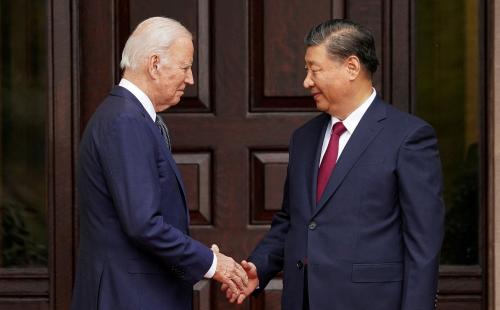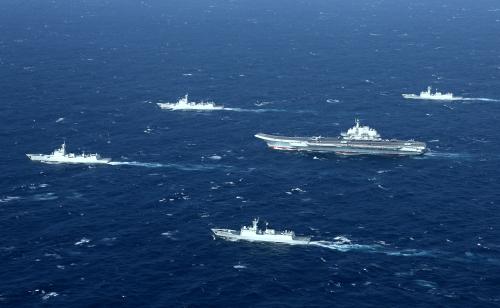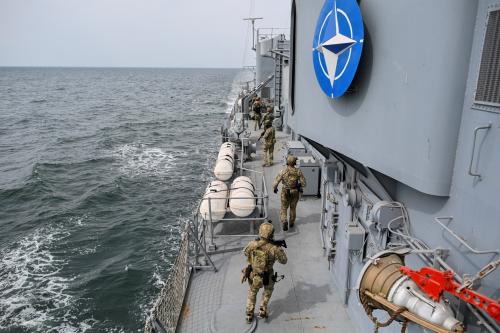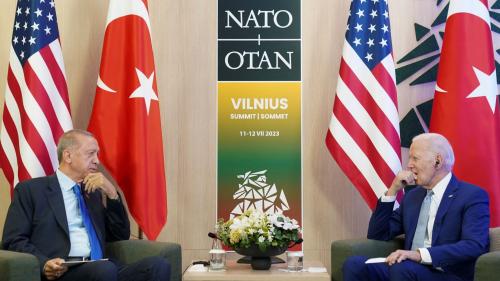When President Joe Biden meets Chinese President Xi Jinping this week in San Francisco, the two leaders will have much to discuss in a badly overdue meeting. But by all accounts, one agenda item will be of dubious promise: Biden’s request that the two countries restore their military-to-military hotline that China has refused to employ in recent years.
It is fine for Biden to make the request, but he should expect “no” to be the answer — and avoid conveying too much U.S. anxiety over the two nations’ military tensions in the Western Pacific. In fact, U.S. anxiety is not just an unintended consequence of Chinese actions — it is likely their very goal. Thus, expressing too much concern would in some ways validate and encourage China’s strategy.
Concerning Chinese provocations
To be sure, the situation is concerning. According to Pentagon data, in the last two years, China has conducted near-intercepts of American aircraft operating in international waters in the Western Pacific at least 180 times — more than in the entire preceding decade. Some have been quite dangerous, as with a recent case where a Chinese plane came within 10 feet of a U.S. bomber. China has also engineered near collisions and even actual collisions involving ships at sea — sometimes with its coast guard or maritime militia rather than its navy, and often at the expense of Filipino vessels as well as the ships of other nations.
Since August 2022, after then-Speaker of the House Nancy Pelosi visited Taiwan, China has also dramatically stepped up the frequency of its military operations past the halfway line between China and Taiwan, a traditional informal barrier between the two countries’ military operations. On one day in September, according to The Washington Post, China actually sent more than 100 aircraft across that line, many all the way to the airspace adjacent to the east coast of Taiwan (but not within Taiwan’s territorial waters/airspace, at least not yet).
Clearly, these provocations are intentional. Among other things, they are likely designed to convince Manila not to pursue Filipino territorial claims in the South China Sea, to persuade the citizens of Taiwan not to push for independence or greater autonomy (including in their upcoming January presidential elections), and to make Washington rethink its entire presence and strategy in the Western Pacific. The efforts are far too systematic for any other interpretation to be plausible. In this regard, our emotions and anxieties are the exact target of Beijing’s actions. Greater unhappiness and nervousness in the United States and elsewhere is probably China’s main tactical goal.
Explaining Chinese behavior
However, if our collective anxiety is the tactical goal, and a realignment of basic power structures in the Western Pacific is the long-term strategic objective, how does Beijing hope that the former can translate into the latter? Of course, we do not really know what Xi and his (rapidly-changing) military leadership team is thinking.
Indeed, especially given the recent firings and hirings within the Chinese armed forces, key leaders may not even all be thinking the same things or have the same concept in mind of how to translate tactical activity into strategic success. But a number of possibilities are plausible:
- Not understanding American politics, Chinese leaders believe that greater tension will somehow convince the United States to weaken its commitments to the Western Pacific region (when in fact the opposite outcome seems more likely).
- Angered by what it sees as an excessive U.S. military presence near its own shores, China is simply responding with the only means at its disposal, and without necessarily having a clear idea of how the pieces should all fit together.
- Feeling emboldened by its recent military buildup and behaving the way bureaucracies, as well as nation states, often do when they have new capabilities, China is flexing its muscles more or less instinctively — and also with the hope of demonstrating a growing power that Xi hopes will give him the capacity to seize Taiwan by 2027 (among other goals).
- Adopting the concept of the late great American strategist Thomas Schelling, China is creating “the threat that leaves something to chance.” Someday, with all this heightened activity, a bad collision with considerable loss of life is bound to occur. At that point, all bets are off as to how the relevant parties (China, the United States, U.S. friends and allies) will respond.
It is this last possibility that American strategists fear most — but that Chinese likely welcome. That is not to say that Beijing wants conflict. Yet it may accept the idea of a crisis, even a crisis with escalatory potential, as its best hope of degrading U.S. influence near its shores. Once such a crisis begins, many things could happen, some of them not easily anticipated. Beijing is likely willing to throw the dice.
A U.S. strategy for China amid uncertainty
It must be the U.S. purpose to show China that its thinking is wrongheaded. A calm, quiet restatement of U.S. commitment to the region, and to its friends, allies, and partners there, is a better path forward than a passionate plea for restoration of a military hotline that China would probably use very inconsistently even if it were restored.
Meanwhile, Biden might also consider an idea that former Deputy Secretary of State Jim Steinberg and I suggested a decade ago — the creation of an “open skies” monitoring mechanism by which China could occasionally fly over parts of the United States (with airplanes — not balloons — and on pre-approved, public flight paths) and the United States could overfly China. We had such a treaty arrangement with the former Soviet states and allies for many years, dating back to the end of the Cold War, so we know that such practices are consistent with the protection of U.S. secrets.
It won’t solve everything, of course. But it may take the edge off China’s frustration that while the United States operates reconnaissance aircraft, ships, and submarines off Chinese coasts every day, the People’s Republic of China does not (yet) have the ability to reciprocate. We can make this good-faith offer at no risk to our own security.
Regardless, Biden should bear in mind that for China, creating tension and some degree of danger in the U.S.-China relationship is not an unfortunate by-product of People’s Liberation Army military activities — it is in fact the likely Chinese goal. To believe otherwise could play into China’s hands and incentivize an escalation rather than a de-escalation of the general military situation in the Western Pacific region.






Commentary
Don’t expect Xi to restore the US-China military hotline this week
Even if the hotline is restored, China seems unlikely to use it much
November 13, 2023